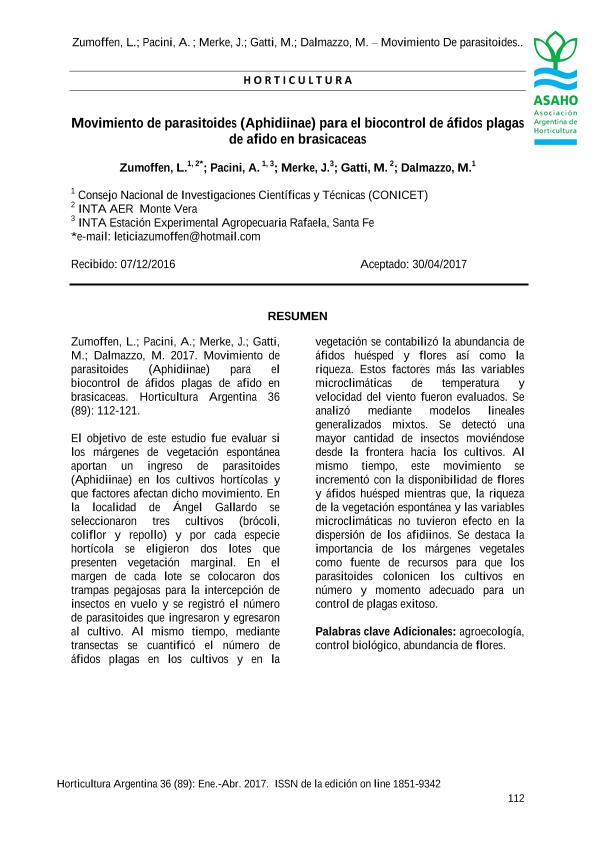Artículo
El objetivo de este estudio fue evaluar si los márgenes de vegetación espontánea aportan un ingreso de parasitoides (Aphidiinae) en los cultivos hortícolas y que factores afectan dicho movimiento. En la localidad de Ángel Gallardo se seleccionaron tres cultivos (brócoli, coliflor y repollo) y por cada especie hortícola se eligieron dos lotes que presenten vegetación marginal. En el margen de cada lote se colocaron dos trampas pegajosas para la intercepción de insectos en vuelo y se registró el número de parasitoides que ingresaron y egresaron al cultivo. Al mismo tiempo, mediante transectas se cuantificó el número de áfidos plagas en los cultivos y en la vegetación se contabilizó la abundancia de áfidos huésped y flores así como la riqueza. Estos factores más las variables microclimáticas de temperatura y velocidad el viento fueron evaluados. Se analizó mediante modelos lineales generalizados mixtos. Se detectó una mayor cantidad de insectos moviéndose desde la frontera hacia los cultivos. Al mismo tiempo, este movimiento se incrementó con la disponibilidad de flores y áfidos huésped mientras que, la riqueza de la vegetación espontánea y las variables microclimáticas no tuvieron efecto en la dispersión de los afidiinos. Se destaca la importancia de los márgenes vegetales como fuente de recursos para que los parasitoides colonicen los cultivos en número y momento adecuado para un control de plagas exitoso. The objective of the study was to evaluate the factors associated with the bidirectional movement of Aphidians between horticultural crops and their marginal vegetation. Three brassicaceae crops (broccoli, cauliflower and cabbage) were selected in the locality of Ángel Gallardo and two lots with marginal vegetation were selected for each horticultural species. In the margin of each lot, two sticky traps were placed for the interception of insects in flight and the number of parasitoids that entered the crop, counted. At the same time, the number of aphid pests in the crops was quantified by means of transects and the abundance of host aphids and flowers as well as richness was counted in the vegetation. These factors plus the microclimatic variables of temperature and wind speed were evaluated using generalized mixed linear models. A greater number of insects were detected moving from the border to the crops. At the same time, this movement increased with the availability of flowers and host aphids whereas, the richness of the spontaneous vegetation and the microclimatic variables had no effect on the dispersion of the aphidiinae. The importance of the plant margins as a source of resources for the parasitoids to colonize the crops in number and at the right time for successful pest control is emphasized.
Movimiento de parasitoides (Aphidiinae) para el biocontrol de afidos plagas en Brasicaceas
Título:
Movement of parasitoids (Aphidiinae) for the biocontrol of aphids aphid pests in brasicaceas
Zumoffen, Leticia ; Pacini, Adriana Cecilia
; Pacini, Adriana Cecilia ; Merke, Julieta; Gatti, Mariano Adrián; Dalmazzo, Maria de Los Milagros
; Merke, Julieta; Gatti, Mariano Adrián; Dalmazzo, Maria de Los Milagros
 ; Pacini, Adriana Cecilia
; Pacini, Adriana Cecilia ; Merke, Julieta; Gatti, Mariano Adrián; Dalmazzo, Maria de Los Milagros
; Merke, Julieta; Gatti, Mariano Adrián; Dalmazzo, Maria de Los Milagros
Fecha de publicación:
04/2017
Editorial:
Asociación Argentina de Horticultura
Revista:
Horticultura Argentina
ISSN:
0327-3431
e-ISSN:
1851-9342
Idioma:
Español
Tipo de recurso:
Artículo publicado
Clasificación temática:
Resumen
Palabras clave:
AGROECOLOGÍA
,
CONTROL BIOLÓGICO
,
ABUNDANCIA DE FLORES
Archivos asociados
Licencia
Identificadores
Colecciones
Articulos(CCT - SANTA FE)
Articulos de CTRO.CIENTIFICO TECNOL.CONICET - SANTA FE
Articulos de CTRO.CIENTIFICO TECNOL.CONICET - SANTA FE
Citación
Zumoffen, Leticia; Pacini, Adriana Cecilia; Merke, Julieta; Gatti, Mariano Adrián; Dalmazzo, Maria de Los Milagros; Movimiento de parasitoides (Aphidiinae) para el biocontrol de afidos plagas en Brasicaceas; Asociación Argentina de Horticultura; Horticultura Argentina; 36; 89; 4-2017; 112-122
Compartir



